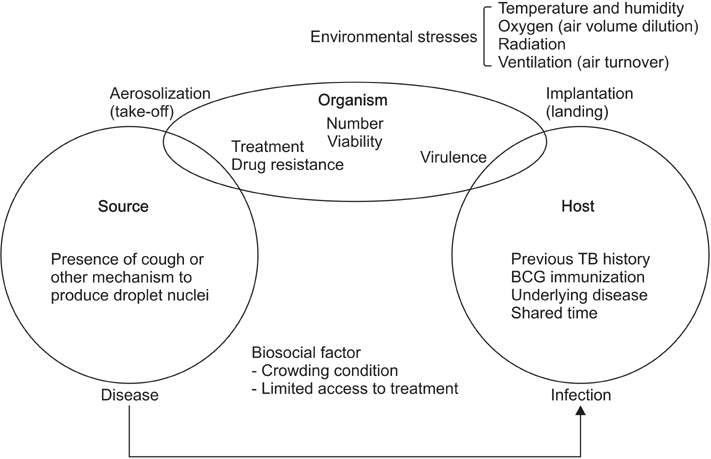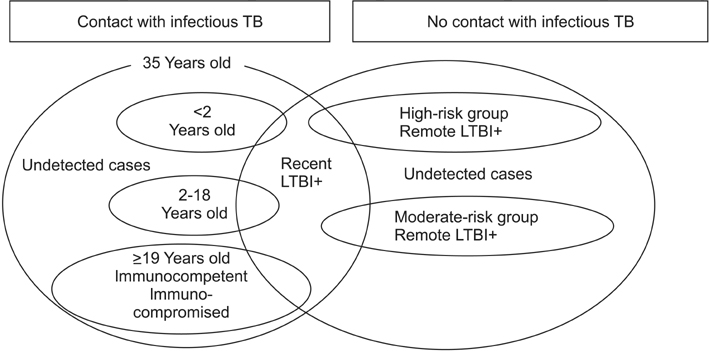Tuberculosis Infection and Latent Tuberculosis
- Affiliations
-
- 1Division of Pulmonary, Sleep, and Critical Care Medicine, Department of Internal Medicine, Korea University Ansan Hospital, Korea University College of Medicine, Ansan, Korea. lee-sh@korea.ac.kr
- KMID: 2365311
- DOI: http://doi.org/10.4046/trd.2016.79.4.201
Abstract
- Active tuberculosis (TB) has a greater burden of TB bacilli than latent TB and acts as an infection source for contacts. Latent tuberculosis infection (LTBI) is the state in which humans are infected with Mycobacterium tuberculosis without any clinical symptoms, radiological abnormality, or microbiological evidence. TB is transmissible by respiratory droplet nucleus of 1-5 µm in diameter, containing 1-10 TB bacilli. TB transmission is affected by the strength of the infectious source, infectiousness of TB bacilli, immunoresistance of the host, environmental stresses, and biosocial factors. Infection controls to reduce TB transmission consist of managerial activities, administrative control, engineering control, environmental control, and personal protective equipment provision. However, diagnosis and treatment for LTBI as a national TB control program is an important strategy on the precondition that active TB is not missed. Therefore, more concrete evidences for LTBI management based on clinical and public perspectives are needed.
MeSH Terms
Figure
Cited by 5 articles
-
Diagnosis and treatment of latent tuberculosis infection
Jinsoo Min, Ju Sang Kim
J Korean Med Assoc. 2019;62(1):11-17. doi: 10.5124/jkma.2019.62.1.11.Diagnosis of pulmonary tuberculosis
Byung Woo Jhun, Hee Jae Huh, Won-Jung Koh
J Korean Med Assoc. 2019;62(1):18-24. doi: 10.5124/jkma.2019.62.1.18.Bibliometric Analysis of Research Productivity in Latent Tuberculosis: Are We Focusing Our Research Efforts on the Right Areas?
Sergio Alejandro Gómez Ochoa, Blanca Beatriz Espín Chico
Tuberc Respir Dis. 2018;81(2):163-165. doi: 10.4046/trd.2017.0109.Treatment of Isoniazid-Resistant Pulmonary Tuberculosis
Byung Woo Jhun, Won-Jung Koh
Tuberc Respir Dis. 2020;83(1):20-30. doi: 10.4046/trd.2019.0065.Impact of Pulmonary Tuberculosis on the
EGFR Mutational Status and Clinical Outcome in Patients with Lung Adenocarcinoma
In Kyoung Hwang, Seung Sook Paik, Seung Hyeun Lee
Cancer Res Treat. 2019;51(1):158-168. doi: 10.4143/crt.2018.084.
Reference
-
1. Frieden TR, Sterling TR, Munsiff SS, Watt CJ, Dye C. Tuberculosis. Lancet. 2003; 362:887–899.2. Dheda K, Barry CE 3rd, Maartens G. Tuberculosis. Lancet. 2016; 387:1211–1226.3. Lillebaek T, Andersen AB, Dirksen A, Smith E, Skovgaard LT, Kok-Jensen A. Persistent high incidence of tuberculosis in immigrants in a low-incidence country. Emerg Infect Dis. 2002; 8:679–684.4. Alland D, Kalkut GE, Moss AR, McAdam RA, Hahn JA, Bosworth W, et al. Transmission of tuberculosis in New York City: an analysis by DNA fingerprinting and conventional epidemiologic methods. N Engl J Med. 1994; 330:1710–1716.5. Small PM, Hopewell PC, Singh SP, Paz A, Parsonnet J, Ruston DC, et al. The epidemiology of tuberculosis in San Francisco: a population-based study using conventional and molecular methods. N Engl J Med. 1994; 330:1703–1709.6. Loudon RG, Bumgarner LR, Lacy J, Coffman GK. Aerial transmission of mycobacteria. Am Rev Respir Dis. 1969; 100:165–171.7. Riley RL, Mills CC, Nyka W, Weinstock N, Storey PB, Sultan LU, et al. Aerial dissemination of pulmonary tuberculosis: a two-year study of contagion in a tuberculosis ward. 1959. Am J Epidemiol. 1995; 142:3–14.8. Reichman LB, Hershfield ES. Tuberculosis: a comprehensive international approach. 2nd ed. New York: Marcel Dekker Inc.;2005.9. Riley EC, Murphy G, Riley RL. Airborne spread of measles in a suburban elementary school. Am J Epidemiol. 1978; 107:421–432.10. Riley RL. Aerial dissemination of pulmonary tuberculosis. Am Rev Tuberc. 1957; 76:931–941.11. Ratcliffe HL, Palladino VS. Tuberculosis induced by droplet nuclei infection; initial homogeneous response of small mammals (rats, mice, guinea pigs, and hamsters) to human and to bovine bacilli, and the rate and pattern of tubercle development. J Exp Med. 1953; 97:61–68.12. Kim JH, Yim JJ. Achievements in and challenges of tuberculosis control in South Korea. Emerg Infect Dis. 2015; 21:1913–1920.13. Lee SH. Diagnosis and treatment of latent tuberculosis infection. Tuberc Respir Dis. 2015; 78:56–63.14. Jensen PA, Lambert LA, Iademarco MF, Ridzon R. CDC. Guidelines for preventing the transmission of Mycobacterium tuberculosis in health-care settings, 2005. MMWR Recomm Rep. 2005; 54:1–141.15. World Health Organization. WHO policy on TB infection control in health-care facilities, congregate settings and households. Geneva: World Health Organization;2009.16. Ninomura P, Rousseau C, Bartley J. Updated guidelines for design and construction of hospital and health care facilities. ASHRAE J. 2006; 48:H33–H37.17. Canadian Thoracic Society. Canadian tuberculosis standards. 7th ed. Ottawa: Canadian Thoracic Society;2013.18. National Institute for Health and Clinical Excellence. Clinical guideline 33. Tuberculosis: clinical diagnosis and management of tuberculosis, and measures for its prevention and control [Internet]. London: National Institute for Health and Clinical Excellence;2011. cited 2016 Apr 2. Available from: http://www.nice.org.uk/CG117.19. Jindani A, Dore CJ, Mitchison DA. Bactericidal and sterilizing activities of antituberculosis drugs during the first 14 days. Am J Respir Crit Care Med. 2003; 167:1348–1354.20. National Tuberculosis Controllers Association. Centers for Disease Control and Prevention (CDC). Guidelines for the investigation of contacts of persons with infectious tuberculosis: recommendations from the National Tuberculosis Controllers Association and CDC. MMWR Recomm Rep. 2005; 54:1–47.21. Joint Committee for the Revision of Korean Guidelines for Tuberculosis. Korea Centers for Disease Control and Prevention. Korean guidelines for tuberculosis. 2nd ed. Seoul and Cheongwon: Joint Committee for the Revision of Korean Guidelines for Tuberculosis, Korea Centers for Disease Control and Prevention;2014.22. Allen EA. Tuberculosis and other mycobacterial infections of the lung. In : Thurbeck WM, Chung AM, editors. Pathology of the lung. 2nd ed. New York: Thieme Medical Publishers;1995. p. 253–254.23. Elkington PT, Friedland JS. Permutations of time and place in tuberculosis. Lancet Infect Dis. 2015; 15:1357–1360.24. Ferebee SH. Controlled chemoprophylaxis trials in tuberculosis: a general review. Bibl Tuberc. 1970; 26:28–106.25. Brooks-Pollock E, Becerra MC, Goldstein E, Cohen T, Murray MB. Epidemiologic inference from the distribution of tuberculosis cases in households in Lima, Peru. J Infect Dis. 2011; 203:1582–1589.26. Esmail H, Barry CE 3rd, Young DB, Wilkinson RJ. The ongoing challenge of latent tuberculosis. Philos Trans R Soc Lond B Biol Sci. 2014; 369:20130437.27. Ryu YJ. Diagnosis of pulmonary tuberculosis: recent advances and diagnostic algorithms. Tuberc Respir Dis. 2015; 78:64–71.
- Full Text Links
- Actions
-
Cited
- CITED
-
- Close
- Share
- Similar articles
-
- Treatment of latent tuberculous infection in children and adolescent
- Host Blood Transcriptional Signatures as Candidate Biomarkers for Predicting Progression to Active Tuberculosis
- Diagnosis and treatment of latent tuberculosis infection
- Diagnosis and Treatment of Latent Tuberculosis Infection in Healthcare Workers
- Survey of Secondary Infections within the Households of Newly Diagnosed Tuberculosis Patients



